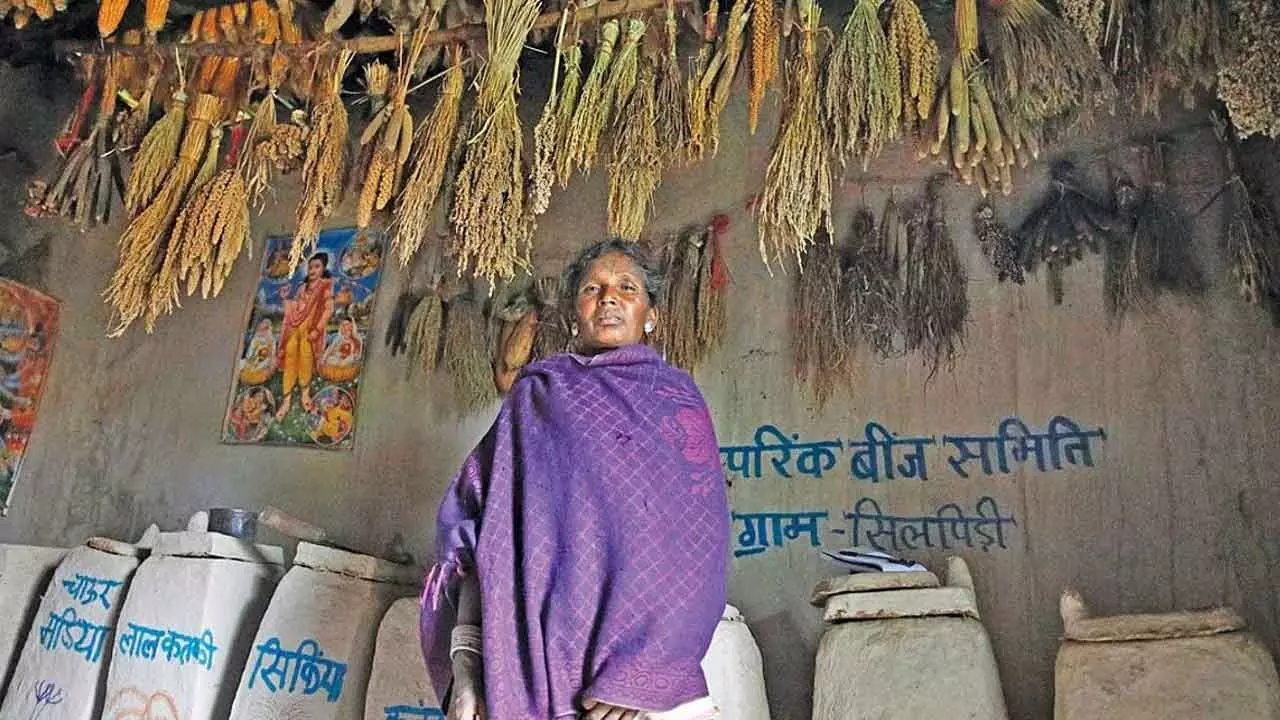Wildlife & Biodiversity: SEED SAVIOURS
Seed banks managed by communities and non-profits are repositories of hundreds of indigenous climate-resilient crop varieties but need help in storage, technical aid and policy support to thrive
Wildlife & Biodiversity: SEED SAVIOURS

A farmer at a community seed bank in Silpidi village of Dindori district, Madhya Pradesh. Farmers who take seeds from the bank return double the volume after harvest Photograph: Vikas Choudhary /CSE
There was a time when women farmers in Machnoor village of Telangana faced shortage of good quality seeds. They were forced to borrow seeds from landlords and would often get them too late or find them to be of poor quality.
Not anymore.
To break this cycle, they decided to save and share their own seeds with each other, leading to the birth of Sangham Seed Bank in 1995, formed with the help of Deccan Development Society, a Telangana-based non-profit. Women from nearly 75 villages are part of the initiative.
The bank stores 80 types of traditional food crops—mainly millets, pulses and oilseeds—that grow well in dry, tough conditions. It also has dryland rice and wheat varieties that need less water and can survive high temperatures.
Farmers with whom the seeds are shared, return double the amount after harvest. Some people even come from far to buy these seeds at a fair price. “The seeds are stored using traditional methods—in palm-leaf baskets, with neem leaves, ash and clay to protect them from moisture and pests. This keeps them safe for two-three years,” says R Santhoshi Srilaya, programme coordinator of the seed bank.
Sangham Seed Bank is just one of the many such organisations across the country storing traditional seeds and knowledge. But there is no data on the numbers or types of seeds that such organisations store, because most of them are informal or unorganised. To assess this critical resource that can provide safety in times of climate change, Delhi-based think tank Centre for Science and Environment conducted an online survey in February-March 2025 and contacted about 60 community seed banks, non-profits and individual farmers. Responses received from 22 community seed banks, 20 non-profits and two individuals show that they collectively own some 887 climate-resilient varieties of 71 crops (see ‘Traditional resource’ on).
Sangam Agrawal, who runs Routes to Roots, a permaculture farm in Neemuch, Madhya Pradesh, is an individual involved in saving seeds. “I started my seed-saving journey in 2020 after finding the benefits they provide—lower costs, climate-resistant crops and better tasting produce,” he says. His farm collects seeds of tomato, brinjal, pearl millet, wheat, papaya, guava and even the rare perennial toor plant (pigeon pea), which grows like a tree and gives up to 15 kg of pulses. The native seeds are stored in glass jars with a bit of ash to keep moisture away. “We seek to share seeds with people who grow food, not with corporations,” he says.
The way seeds are shared depends on local factors. While the most common method is seed-loan system, where farmers borrow seeds at the beginning of the growing season and return twice the quantity post-harvest, in tribal areas, there are banks that provide seeds for free. These distribution mechanisms collectively ensure that indigenous seeds remain in active cultivation and retain viability.
But there are massive challenges. Financial sustainability remains a major hurdle, since most seed banks operate independently, says Sayan Sau, who works with West Bengal based SwitchON Foundation. To compensate for this gap, many seed banks have formed partnerships with research institutions and non-profits.
Another challenge is that traditional seed storage methods are not always effective in preventing moisture damage, pest infestations or fungal infections. Agriculture departments could provide the necessary resources such as containers made of wood or mud, and infrastructure for seed storage. Seed banks also face a shortage of technical expertise. Without regular training on seed testing, viability assessment and genetic purity maintenance, some farmers receive low-germination or poor-quality seeds, reducing their trust in community owned seed banks.
Lack of supportive government policies is the other major issue. It was only in 2001 that the Protection of Plant Varieties and Farmers’ Rights Act was adopted. The Act recognised the rights of both plant breeders and farmers. It allowed farmers to save, exchange and sell seeds of registered varieties, except under branded names. Communities conserving traditional crop varieties could claim benefits if the genetic material was used commercially. Under this, traditional crop varieties bred by farmers could be registered and protected. The Act encouraged the formalisation of conservation of indigenous genetic resources, paving the way for community seed banks and participatory seed conservation initiatives.
However, there are major implementation issues because farming communities continue to struggle to register their traditional seed varieties due to complex procedures and lack of support. “There is currently no specific policy framework governing community seed banks. While India has laws such as the Protection of Plant Varieties and Farmers’ Rights Act, 2001, and the Seeds Act, 1966, these do not provide clear guidelines for managing community seed banks. The proposed Seed Bill of 2019 is still under discussion, and efforts are going on to develop policies that recognise farmer–managed seed systems,” say Rengalakshmi Raj and Prajeesh Parameswaran of M S Swaminathan Research Foundation based in Chennai.
(This analysis was originally published in the June 1-15, 2025 print edition of Down To Earth)

